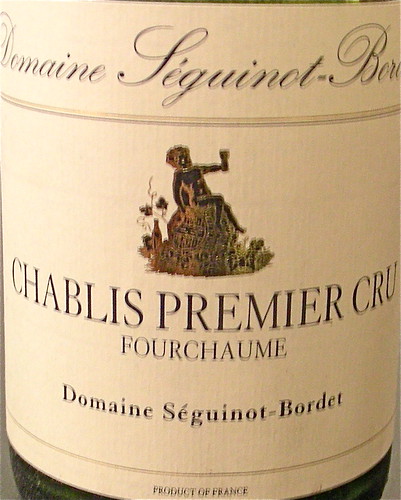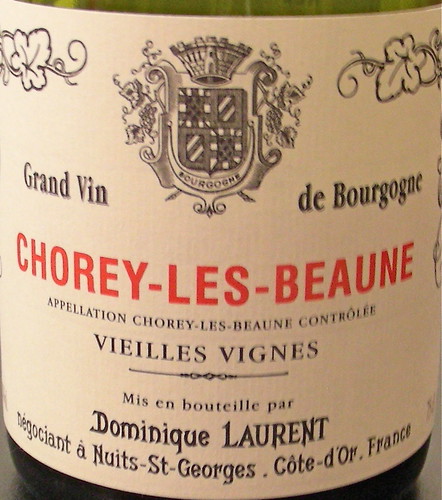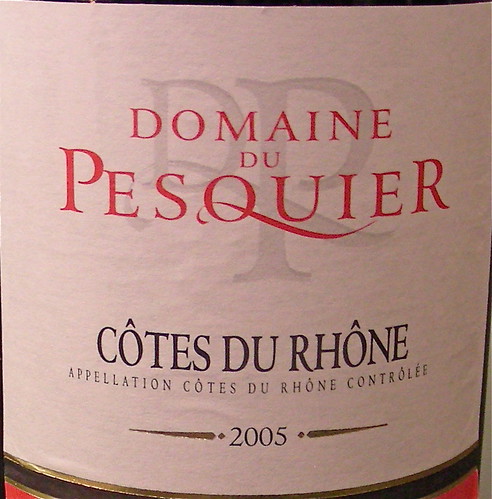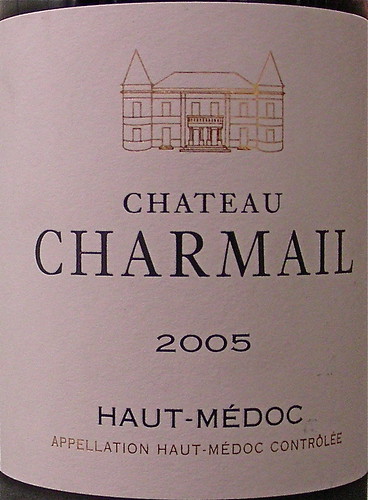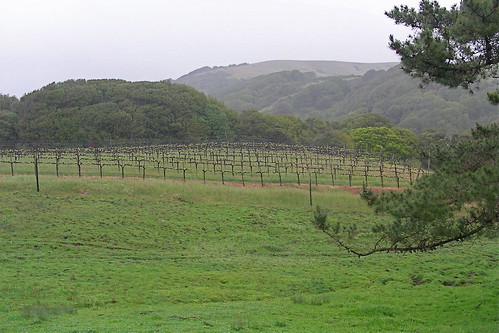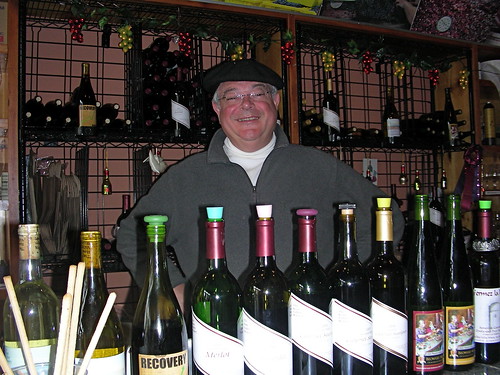Earlier this year, our wine tasting group met again, this time for a blind tasting of Cabernet blends from Washington state. Each guest brought a mystery bottle that was quickly covered by one of our homemade purple velvet bags with a random letter pinned to it. The guests had to also bring their own glasses to be placed in a semi-circle in front of them, one glass for each wine.
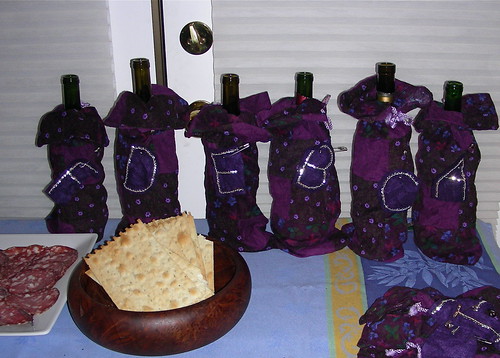
The bottles are ready to be tasted blind 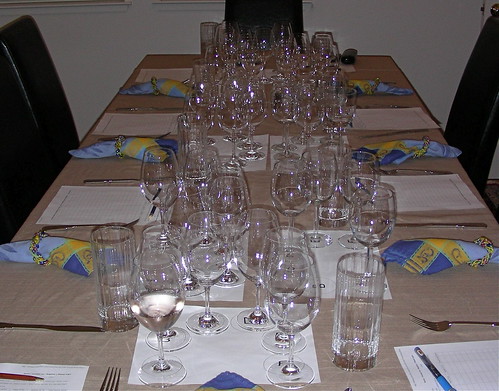
The tasting setupAlthough about 50 years ago, there was no serious wine made in
Washington State, it has quickly become the second largest fine-wine-producing state after California. Originally, Washington was mostly a white wine producing region, primarily using Chardonnay. Nowadays, it's more like 52 percent white to 48 percent red, the most widely planted grapes being Chardonnay, Cabernet Sauvignon, and Merlot.
Geographically, Washington State is located approximately on the same latitude (46ºN) as Bordeaux and offers a variety of very different climates. Western Washington, west of the Cascade Mountains, has a oceanic climate with relatively mild temperatures and wet, cloudy winters. Only 1% of the state's wine grapes are grown there. The other 99% of the wine grapes are grown east of the Cascades where the climate is semi-arid with long daylight hours during the growing season.
Here are the wines that we tasted:
 2001 Seven Hills Reserve Cabernet Sauvignon Walla Walla Valley
2001 Seven Hills Reserve Cabernet Sauvignon Walla Walla Valley: founded in 1988,
Seven Hills Winery is one of the region's oldest and most respected wineries, producing wines from the Columbia and Walla Walla valleys as well as Oregon's Willamette Valley.
Walla Walla Valley is the most remote Washington wine region located at the Southeastern corner of the State. Although
Walla Walla is a Native American name that means
Place of Many Waters, the area has dry, arid conditions and cold winters. Our notes: nose of sweet fruit, herbs, and anise, medium-bodied with notes of oak, fresh, light finish. Ranked fifth place.
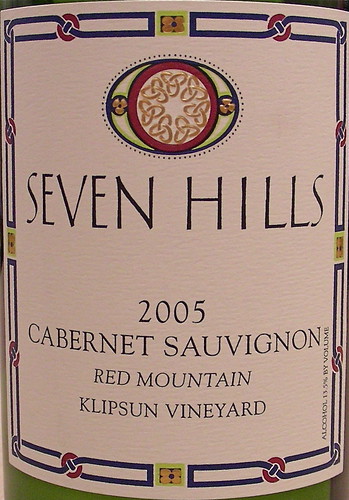 2005 Seven Hills Cabernet Sauvignon Klipsun Viyeyard Red Mountain
2005 Seven Hills Cabernet Sauvignon Klipsun Viyeyard Red Mountain: the wine comes from the 120-acre Klipsun Vineyard on the western slope of the
Red Mountain appellation.
Klipsun means sunset in the Chinook Indian language. The soil is shallow with sand and silt. Our notes: mint and eucalyptus on the nose, round and chewy on the palate, good flavors. Ranked third place.
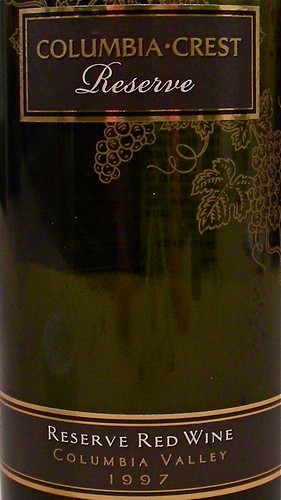 1997 Columbia Crest Reserve Red Wine Columbia Valley
1997 Columbia Crest Reserve Red Wine Columbia Valley: founded in 1983,
Columbia Crest has grown from a small winery in a relatively unknown wine region to one of the largest wineries in the United States. By 1990, wine critic Robert Parker had named Columbia Crest one of the 24
best value wineries. The wine is a blend of Cabernet Sauvignon (39%), Merlot (39%) and Cabernet Franc (22%) sourced from four
Columbia Valley vineyards. Our notes: sweet red fruits on the nose, supple, tasty, meaty on the palate with aromas of raspberry liqueur, Bordeaux-like, food friendly. A big favorite, ranked first place.
 2001 Kiona Reserve Cabernet Sauvignon Red Mountain
2001 Kiona Reserve Cabernet Sauvignon Red Mountain: founded in 1972,
Kiona Vineyards and Winery is a family-owned and operated estate that pioneered the development of the
Red Mountain AVA. Red Mountain is part of the Yakima Valley AVA, which in turn is part of the larger Columbia Valley AVA.
Kiona is a Yakima Indian name that means
brown hills. Our notes: subtle nose, tobacco and chocolate on the nose, nutty and flavourful palate, medium finish, well balanced, opens up nicely in the glass. Ranked second place.
13.9%
 2006 Isenhower Red Paintbrush Columbia Valley
2006 Isenhower Red Paintbrush Columbia Valley: founded in 1999,
Isenhower Cellars is a boutique winery located south of Walla Walla. It produces wines using fruits coming from a variety of sources in the Columbia Valley. Their 2006 Red Paintbrush is a blend of 67% Cabernet Sauvignon, 17% Cabernet Franc, 11% Merlot, and 5% Petit Verdot. Our notes: fresh raspberry and cocoa on the nose, tight on the palate, too young, a bit harsh on the finish. Ranked sixth place.
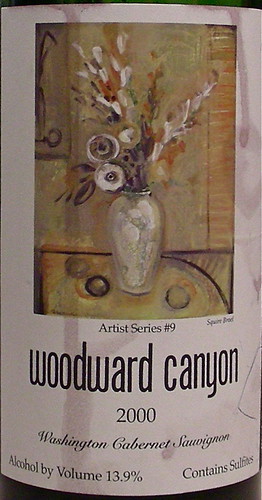 2000 Woodward Canyon Artist Series #9 Cabernet Sauvignon
2000 Woodward Canyon Artist Series #9 Cabernet Sauvignon:
Woodward Canyon Winery was one of the first two wineries (with
Leonetti Cellars) to help put the Walla Walla Valley on the Washington wine map. The Artist Series started in 1992 to showcase Washington State Cabernet Sauvignon. The label changes every vintage with work from different local, Pacific Northwest artists. Our notes: chocolate and pepper on the nose, full bodied, tannic, good finish. Ranked fourth place.
Technorati tags: wine food & drink
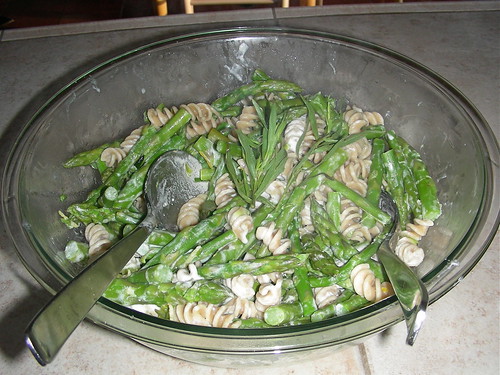
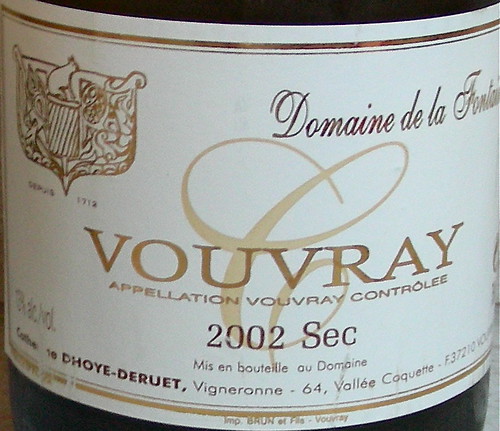 Domaine de la Fontainerie has five hectares in production in the Vouvray appellation where the family has been growing Chenin Blanc since 1712. Catherine Dhoye-Deruet, who is now in charge of the family estate, would typically vinify her Vouvray dry and make off-dry and sweet Vouvray in exceptional vintages only. She believes in minimal intervention in the vineyard and harvests her grapes manually.
Domaine de la Fontainerie has five hectares in production in the Vouvray appellation where the family has been growing Chenin Blanc since 1712. Catherine Dhoye-Deruet, who is now in charge of the family estate, would typically vinify her Vouvray dry and make off-dry and sweet Vouvray in exceptional vintages only. She believes in minimal intervention in the vineyard and harvests her grapes manually. 
